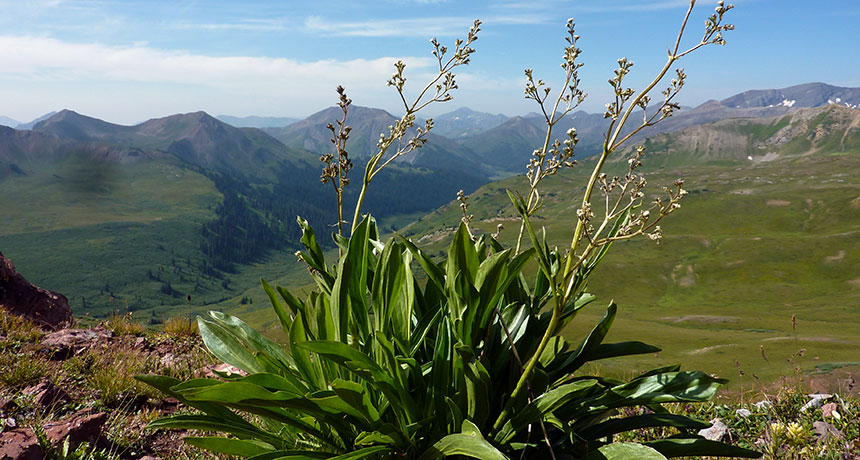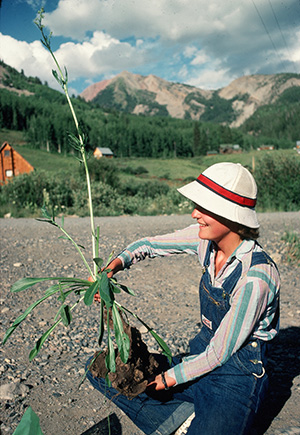Warming alters mountain plant’s sex ratios
Mid-elevation male-female balance now shifted to higher altitudes, study finds

MOUNTAIN CLIMBER Male valerian plants like this one have moved up in elevation in response to hotter, drier climate conditions. As a result, male-female plant ratios have changed since the late 1970s, researchers have found. This plant is growing in the research team’s highest study site, at 3,790 meters.
W. Petry
- More than 2 years ago
In Colorado’s Rocky Mountains, male and female valerian plants have responded differently to hotter, drier conditions, a new study shows. Rapidly changing ratios of the sexes could be a quick sign of climate change, the researchers say.
Valerian (Valeriana edulis) plants range from hot, scrubby lowlands to cold alpine slopes. In each patch of plants, some are male and some are female. The exact proportion of each sex varies with elevation. High on the mountain, females are much more common than males; they can make up 80 percent of some populations.
Four decades ago, in patches of valerian growing in the middle of the plant’s elevation range, 33.4 percent of the plants were males. Those patches grew in the Rockies at elevations around 3,000 meters. Today, you would have to hike considerably higher to find the same proportion of male plants. Males, now 5.5 percent more common on average, are reaching higher elevations than in the past, researchers report in the July 1 Science.
“We think climate is acting almost like a filter on males and females,” says Will Petry of ETH Zurich, who led the study while at the University of California, Irvine. “The settings on this filter are controlling the sex ratio.” Those settings are sweeping up the mountainside like a rising tide at a rate of 175 meters per decade, Petry and colleagues found.

Ecologists already knew that the ratio of male to female plants can vary with altitude or water availability, says ecologist Spencer Barrett of the University of Toronto, who was not involved in this study. But “the idea that a sex ratio is moving upslope — nobody’s ever done that before.”
Those moving sex ratios have kept pace with climate change since the late 1970s. Today, winter snows are melting earlier and summers are hotter, with less rain. As a result, the same amount of precipitation that would have fallen at one elevation in 1978 now falls at higher elevations instead; it has moved upslope by 133 meters per decade. Soil moisture has moved up the mountain, too, by 195 meters per decade.
The parallel shifts mean that changing sex ratios could be a marker of climate change, says population biologist Tom Miller of Rice University in Houston, a coauthor of the study. Today, movements of whole species — often up in latitude or altitude — are a hallmark of climate change. But proportions of males and females are changing “substantially faster than species are moving,” Miller says. They “might be a much more rapid fingerprint of climate change than where species are migrating to.”
Petry’s team found that fingerprint while hiking around the Rocky Mountain Biological Laboratory in Crested Butte, Colo. As the scientists walked through the mountains in Chaffee and Gunnison counties, they counted flowering males and females at 31 sites in 2011, then compared their modern data with historical counts from nine of the same populations, made by coauthor Judy Soule from 1978 to 1980. When Petry saw that the percentage of males and females had changed, “we also started thinking about the consequences,” he says.
If one sex vastly outnumbers the other, populations could die out. “Imagine if it became an Amazonia situation,” says Kailen Mooney, whose lab at UC Irvine led the new study. A 100 percent female population wouldn’t be pollinated, and would disappear once the mature females died, he says.
If those female-only populations grew above a certain altitude and died out because males couldn’t reach them, then male plants would set the upper boundary for the whole species. Sex ratios “add nuance” to the way scientists think about climate-driven migration, Mooney says, because one sex could determine geographic limits for whole species.






